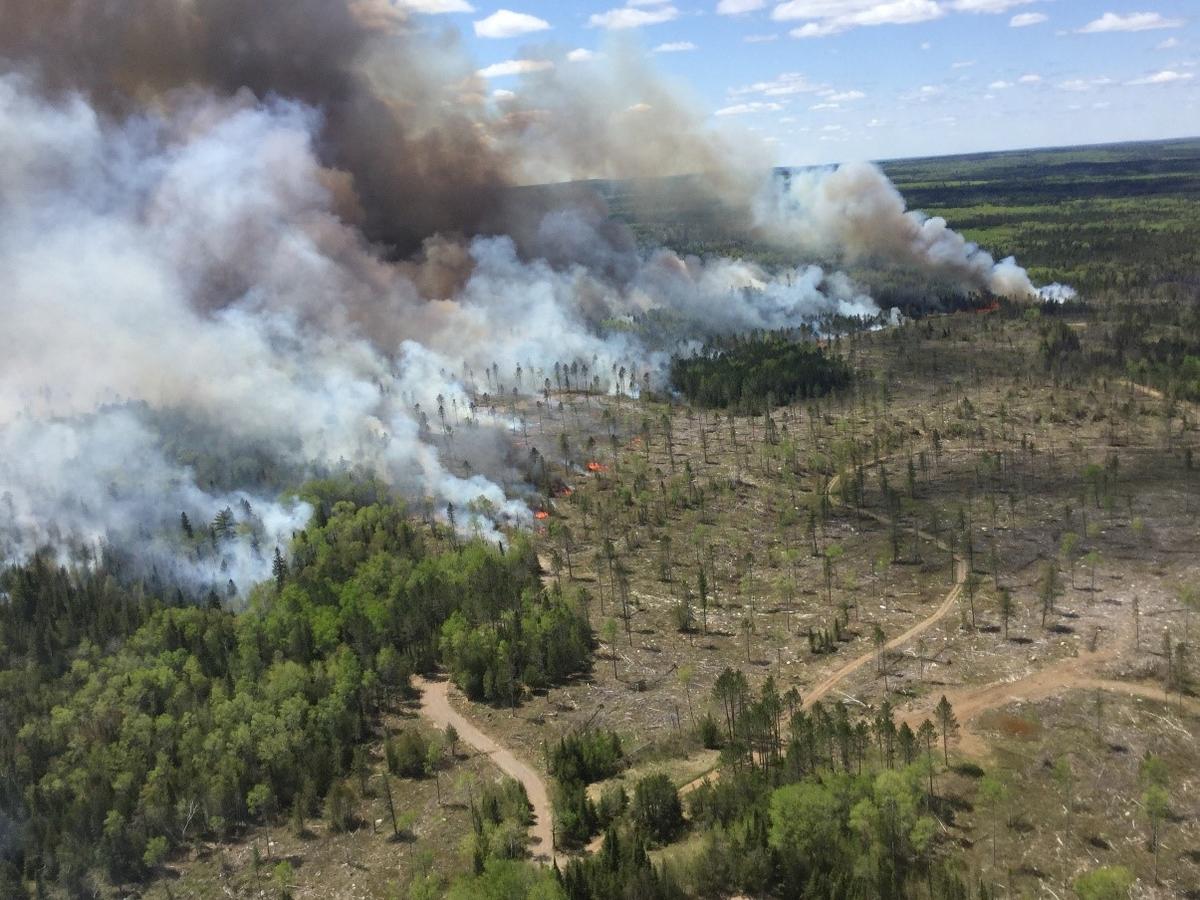Overview
This project was developed and implemented by an inter-disciplinary team. Multiple natural resource objectives were in play as well as trying to work together to learn how to better layout treatments that are practical for commercial harvest, prescribed burning, and reforestation operations. We also wanted to see if we could bring down the cost of site prep burning by using almost all natural boundaries and existing roads. The variety of configurations of leave trees, reserve areas, and burn inclusions were applied to mimic natural burn features. Of the 781 acres, 324 acres were harvested and 700 acres were burned.
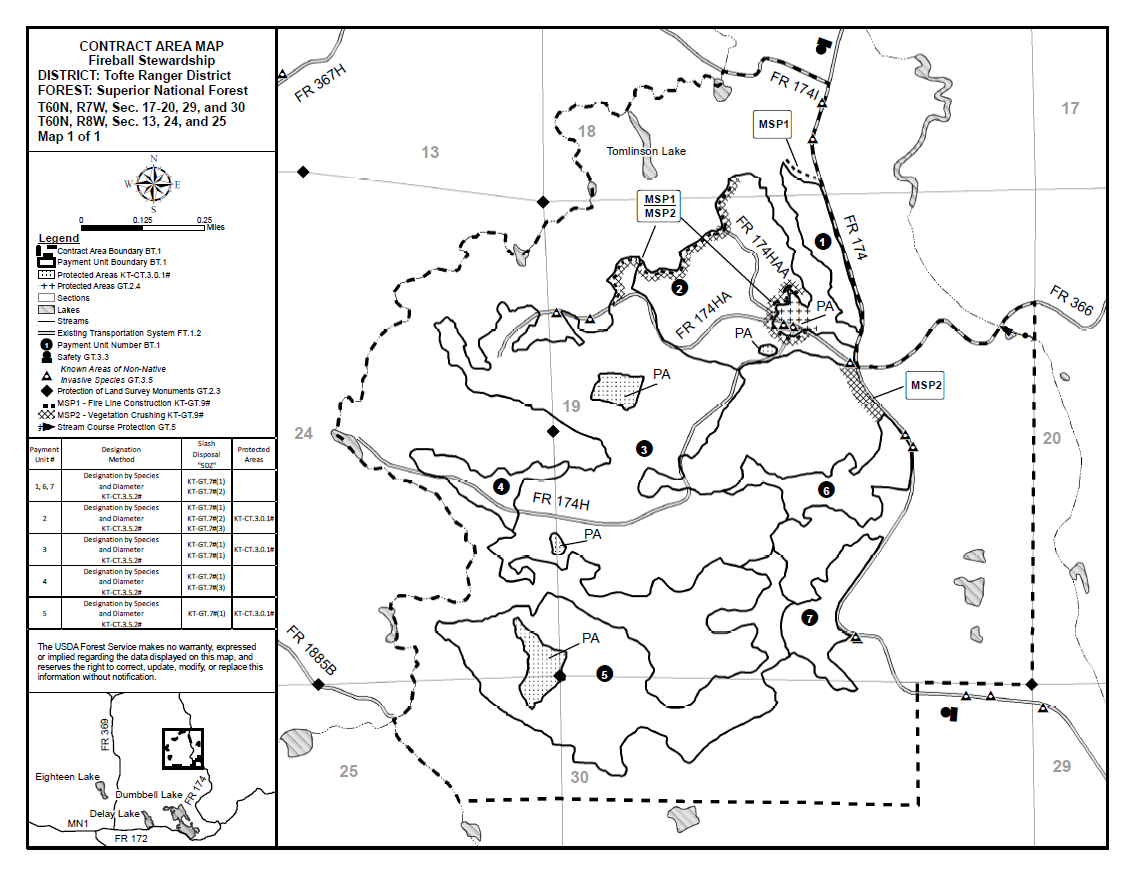
Figure 1: Map of stewardship contract. Site prep burn implementation was approximately the dotted sale area boundary west of FR 174.
Silviculture Objective(s)
- Establish a large young patch more indicative of natural disturbances (Spatial patterns, wildlife habitat objectives)
- Pine stands: establish young mixed stands of jack pine and red pine, increase the jack pine component of the project area on jack pine sites (Vegetation/Wildlife objectives)
- Mixed aspen-birch-spruce-fir stands: establish young mixed aspen-birch-spruce-fir (Vegetation/Wildlife objectives)
- Reduce fuel loading and fuel continuity at a landscape/patch level (Fire/Fuels objectives)
- Utilize revenue of timber from a stewardship contract to fund prescribed burning, reforestation, and wildlife habitat improvement activities
Pre-treatment stand description and condition
Pre-treatment species composition:
The project covers harvesting and burn inclusion treatments within the Windy Decision Notice (2014). The project includes a large upland area east of Tomlinson Creek and west of Dumbell River Road (FR174). Much of the area was harvested near the time of stand initiation, and areas were converted to red pine plantation. There is an historic logging camp and mill site within project area.
This project covers multiple red pine stands, covering 219 stand acres. These stands are on average 65 years old with 10" dbh and about 110 ft2/acre BA. In addition to red pine, these stands have a strong jack pine component and some units also have a fair amount of black spruce and hardwoods. Some units were thinned in 2004 and 2005, though response to thinning was not vigorous. For this reason and site conditions, it was determined to increase jack pine composition, which is also a forest plan objective. On Tofte, regenerating red and jack pine together has been successful in managed stands – jack pine is harvested when mature, releasing the red pine.
Of pine, there were an additional 23 stand acres of jack pine with a substantial hardwood component. The stands are on average 65 years old with 9" dbh and about 120 ft2/acre BA.
For hardwood types there were 177 stand acres of aspen, birch, and mixed aspen-birch-spruce-fir stands. These stands are on average about 75 years old with 10" dbh and about 90 ft2/acre BA. Some hardwood stands have a substantial jack pine component as well.
138 acres of forested stands were included in the project as burn inclusions for prescribed burn operations. These acres were either inoperable or were included because they were in between an upland harvest area and a water feature that would serve as a natural holding boundary. Lowland conifer types also served as a natural holding boundary.
|
Existing vegetation stand type by – Planned Treatment |
GIS stand Acres |
|
Burn Inclusion |
309 |
|
Jack Pine |
19 |
|
Balsam Fir |
15 |
|
Lowland Black Spruce |
50 |
|
Upland Jack Pine/Black Spruce |
34 |
|
Cedar/Aspen/Paper Birch |
19 |
|
Red Pine |
2 |
|
Open (lowland brush or water) |
171 |
|
Clearcut with Reserves |
472 |
|
Jack Pine |
24 |
|
Upland Jack Pine/Black Spruce |
21 |
|
Cedar/Aspen/Paper Birch |
30 |
|
Red Pine |
219 |
|
Quaking Aspen |
18 |
|
Paper Birch |
2 |
|
Mixed Aspen-Birch-Spruce-Fir |
159 |
|
Grand Total |
781 |
Pre-treatment forest health issues:
Increasing forest composition in balsam fir was leading to increasing susceptibility to spruce budworm in future. Diplodia and Sirococcus shoot blights were a concern in red pine. There was concern of red pine in a plantation setting on sites better suited to jack pine.
Silviculture Prescription
Primary treatment: Clearcut with reserves. Harvest merchantable aspen, birch, fir, spruce, jack pine, and red pine. Leave tree preference: red pine, jack pine, spruce, birch, aspen, and then fir. When identifying leave trees and leave areas, consider fire behavior and favor areas such as north facing slopes and low wet areas. Favor clumped leave areas and reserve trees where practical to create leave areas without slash. Avoid putting leave trees and legacy patches within 100 feet of the payment unit perimeter. Distribute harvest slash evenly across the unit for burning. Retain and scatter tops to get seed cones across the site.
Secondary treatment: Site prep burn as much of the stands that are in the project area for harvest as possible, including areas not harvested. If practical, burn the entire project at one time. Burn under conditions that will maximize mineral soil exposure for tree regeneration. Mortality in leave trees and reserve areas is expected. If site prep burn does not occur within 2 years of harvest, then mechanically prepare the site.
Reforestation:
Red pine stands: Seed a mixture of 50/50 red pine, jack pine; if surveys to not show adequate regen from seeding, then plant. Monitor survival. Release as needed. Certify at 400 conifer per acre.
Mixed aspen stands: Natural regeneration. Monitor stocking. Certify regen at 4000 tpa aspen, 1000 tpa birch, 400 tpa conifer, or 1500 tpa aspen/birch/coni mix.
Burn Inclusions:
Objective is to increase flexibility and effectively burn at a landscape scale. Allow prescribed fire in adjacent areas to be held at natural boundaries. Fire may enter the stand but the objective is not to burn the standing timber. Ignite or suppress fire in unit if needed for holding. If more than 40% of the unit burns, monitor stocking.
What actually happened during the treatment
The hardwood units were successfully harvested in fall 2017 (Payment units 4- 7, 123 acres) and red pine and jack pine units in fall 2018 (Payment units 1-3, 201 acres) as part of a stewardship contract. Reserve trees/area prescription was met by leaving 1 mature tree every 70 feet as a contract provision. A 5 acre reserve area was marked to be left in red pine payment unit 3. Conventional harvesting equipment was used. Slash was redistributed from the landing back onto the unit with a grapple skidder for the prescribed burn. A small portion of dozer line for the burn was put in along the north end of the project area as part of the contract service work done by the operator.
A site prep burn was implemented with helicopter ignitions June 3rd of 2019 for a total of 700 acres treated, including harvest units. Fire was allowed to back and carry into burn inclusion acres. By in large, fire did not carry more than 50 feet into hardwood or lowland forested stands within burn inclusions. Initial observations were that mineral soil exposure objectives were successfully met especially in pine harvest units, but had more of a mosaic pattern within hardwood harvest units.
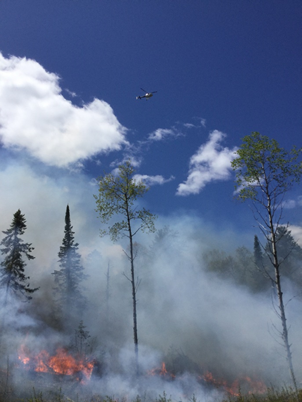
Figure 2: Helicopter ignitions.
After assessing the post burn results and seedling availability from the nursery, the plan was amended from seeding to direct planting of 50/50 red pine, jack pine mix at 600 trees per acre spring 2020. The remaining acres will be monitored for natural regeneration.
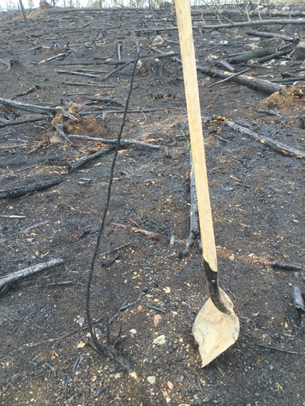
Figure 3: Immediate post burn effects on an aspen root sucker. Mineral soil exposure.
Post-treatment assessment
All contract provisions were followed within the stewardship contract and met objectives. At this time, a walk through and team visit by specialists visited the site and determined the burn met desired objectives. The 5 acre reserve island in unit 3 did experience heavy mortality due to balsam fir understory. The individual reserve trees experienced a mix of mortality as seen observed after the burn.
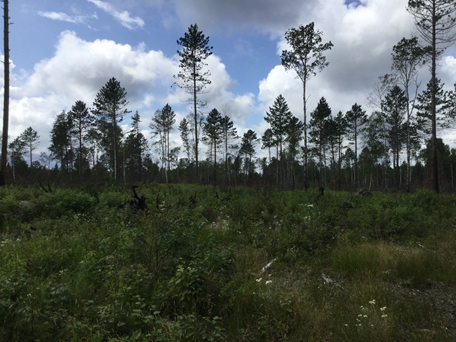
Figure 4: Post treatment within clearcut harvest unit. Distribution of leave trees.
Stocking surveys for natural and planted regeneration will be implemented to monitor stocking and vegetation competition with the requirement to certify the site reforested within 5 years. Pre and post treatment fuels plots will continue to be monitored to document treatment effectiveness. Soils effects and water quality will continue monitoring within the unit and the adjacent Tomlinson Creek.
Plans for future treatments
Planting activity is scheduled for spring 2020. Tree release and weed treatment will be planned as needed through stocking survey assessment. At year 40, the mixed jack pine red pine stands will be evaluated for thinning. At year 50, the aspen, birch, mixed hardwood stands will be evaluated for regeneration harvest.
Costs and economic considerations
The total volume of timber sold was 7,572 CCF (4,680 MBF).
For the harvested units, the site prep burn cost $123/ac ($35,000/324 ac.), much lower than our typical site prep costs.
2020 Planting costs planned are $314/ac or $59.660 total.
Other notes
This case study was developed with support from the United States Department of Agriculture's National Institute for Food and Agriculture (USDA-NIFA), Renewable Resources Extension Act (RREA). Project #MIN-44-E02, principal investigator Eli Sagor, University of Minnesota.
References:
USDA, Superior National Forest (2004) Superior National Forest Land and Resource Management Plan. Duluth, MN.
Ontario Ministry of Natural Resources (2002) Nature’s Way – The Guide for Natural Disturbance Pattern Emulation for Forest Harvesting. Peterborough, ON Canada.
Climate Adaptation Considerations
Regenerating more than one species on the site makes the stand more resilient in the future. Jack pine is a ‘loser’ in the future climate projection models but red pine has been modeled to be more stable. These considerations were balanced with site conditions and forest plan objectives.
Summary / lessons learned / additional thoughts
This project was years in the making. Careful coordination occurred between all members of the interdisciplinary team and layout personnel. Fire and wildlife specialists worked directly with timber sale preparation and sale administrators in order to layout units in a way that facilitated burning at a large scale to achieve desired objectives. Timing between a two year contract period, markets, and burn windows was the greatest hurdle to full implementation. Ideally the pine units would have been cut first (2 year slash) before the aspen/birch units (1year old slash) for better burn results, but markets at the time dictated the opposite. Balsam fir within the reserve areas was the main cause of tree mortality and needs to be addressed if reserve areas are to be preserved, adding to treatment cost. Still, stewardship contracting proved an effective tool for implementing the harvest with prescribed burn prep work and achieved landscape level management.
